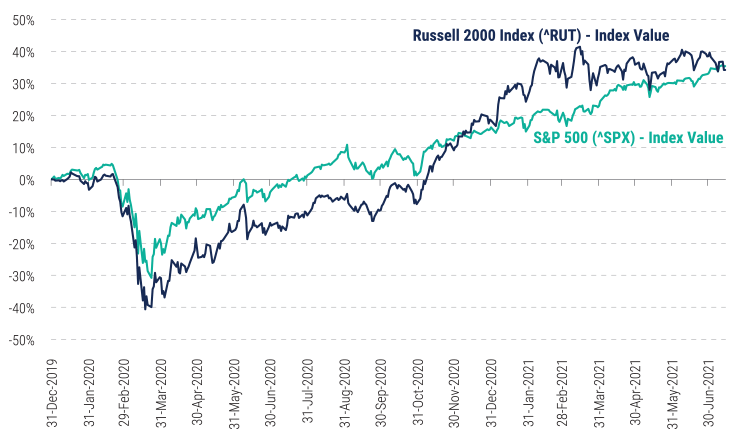Select your geography
Americas
Private Funds Outlook: In Private Equity Markets, Covid-Era Realities Drive Opportunities

Steven Costabile, CFA
Global Head of Private Funds Group

As we enter the home stretch of 2021, we have continued to see a consistent and sustainable recovery for global markets since the pandemic-related trough in March 2020. Unlike past crises, the Covid-19 pandemic brought on a sharp downturn followed by a quick recovery across the global markets – and today, most public and private equity markets have either fully recovered or are exceeding pre-crisis levels. A silver lining of the crisis has been its role as a catalyst for positive disruption in certain industries and sectors, and the “Covid new normal” is driving how we think about new investment opportunities going into next year.
The strength and velocity of the recovery were aided in part by the absence of a systemic crisis in the financial and banking sectors. At the same time, the unprecedented interventions by developed market central banks and governments’ fiscal stimulus plans have also solidified global economies’ ability to bounce back quickly.
These factors have helped foster an environment where unprecedented amounts of capital were raised to support transaction activity across the alternative markets.
S&P 500 and Russell 2000 Returns Since Fourth-Quarter 2019

Source: FactSet as of 16 July 2021
Fundraising takes off
The accommodative macro environment has resulted in prolific fundraising activity, with over $379 billion of primary capital raised across 540 funds in the first half of 2021, compared to $190 billion across 401 funds in the first half of 2020 and $264 billion across 433 funds in the same period of 2019.1
While several large-cap names closed on $10 billion-plus funds, the middle market also benefited from the rising tide. Out of the industry numbers mentioned above, middle-market funds raised $111 billion in fresh capital during the first half of 2021, far surpassing the $92 billion committed in the first half of 2019.2
The macro-environment has also supported robust deal-making. In the US alone, 1,182 private equity deals closed for a combined $135 billion in the first quarter of 2021.3 In Europe, a record 1,113 deals closed for a combined $109 billion in the first quarter of 2021.4
Tapping opportunities
At the same time, we have observed a lengthening in the fundraising cycle for mid-market managers from 14 months in 2020 to 18 months to date in 2021. In our view, this lengthening of the capital-raising period tends to generate attractive “early secondary” investment opportunities with substantial portfolio visibility and co-investment opportunities toward the final close of such funds.
Another impact of the pandemic has been a challenging fundraising environment for first-time managers. Travel restrictions, the inability to perform on-site due diligence, and allocation shifts among institutional limited partners (LPs) toward established managers have resulted in a shortage of capital for new managers. In 2020, first-time managers accounted for only 12% of private equity capital raised globally, a 15-year low, compared to around 18% in 2019. Allocation remained muted in the first half of 2021, at 14%.5 We see this as an opportunity to obtain better economic terms from such opportunities.
Regional and sector pivots
From a regional standpoint, the proportion of investors targeting Asia-Pacific private capital funds has increased from 26% in 2015 to 39% in 2020. For comparison, the proportion of investors targeting North American private capital funds declined from 51% in 2015 to 45% in 2020, while for Europe, the figure declined from 18% to 11% over the same period. As of September 2020, Asia-Pacific-focused private capital assets under management totaled a record $1.7 trillion, up 280% in five years. This compares to increases of 80% and 107%, respectively, for private capital assets in North America and Europe over the same period. Asia’s higher growth trends reflect a burgeoning middle class with the fastest-growing pension assets globally (at 7% annualized for the last five years ended December 2020).6
That said, the existential challenges facing Evergrande, the huge and highly indebted Chinese real estate developer with broad linkages in the Chinese economy, have investors asking how much systemic risk the company poses. We believe authorities can and will intervene to prevent spillovers to the broader property market and financial system to avoid systemic risk. Nevertheless, we think developed market institutional investors may reconsider their legacy Chinese private equity exposure and choose to do some rebalancing. From our perspective, this would present an opportunity to acquire certain assets at a discount to their intrinsic value, and investors that are longer-term oriented may find value in a potential broad rebalance of Chinese private markets.
Turning to the secondary market, we have observed similar fundraising trends, with a record $86 billion raised in 2020 across 38 secondary funds, more than doubling the $22 billion raised in 2019. With $33 billion committed across 22 secondary funds in the first half of 2021, annual fundraising activity looks set to remain elevated as LPs and investors alike seek more liquidity and flexibility across their allocations and strategies.7
As for secondary transaction volumes, we have observed an increase of 167% from $18 billion in the first half of 2020 to $48 billion in the first half of 2021, eclipsing the previous record of $42 billion for the first half set in 2019. 8
General partner (GP)-led volume accounted for 60% of this total, representing a new normal of the relative balance between GP- and LP-led deals. Against a backdrop of pent-up buyer demand for high-quality assets, a continued supply of GP-led deals, and traditional LP sellers returning to the market, the 2021 annual secondary volume is expected to exceed the previous high of $88 billion set in 2019.9
During the pandemic, we have observed LPs shifting their allocations toward sector-focused managers who they believed would better capture the benefits from disruptions related to Covid. Among such sectors, the technology and healthcare specialists benefited from a large inflow of capital. A similar trend was observed in the secondary market. The tilt toward technology has also been reflected in market-cap-weighted public indices, with the sector’s weight in the S&P 500 increasing from 23% in December 2019 to 28% in December 2020, before stabilizing at 27% in July 2021.10
Valuations recover and hit new highs
Today, valuations in some sectors have returned to or surpassed pre-Covid levels. These have been fueled by continued abundant liquidity driven by supportive fiscal and monetary policies, mainly across the developed market economies. For instance, global median buyout multiples for the most expensive sector, technology, reached a new high of 20.1x in 2020, up from 15.3x in 2019 and more than double the valuation from a decade ago.11
Further, historically low interest rates12 and the unabated global search for yield, along with a surge in capital raised for SPACs (special purpose acquisition companies), support the ability to execute mergers and acquisitions with ever-increasing valuations.
As of first-quarter 2021, median rolling four-quarter buyout multiples in the US remained high at 12.7x EBITDA across deals financed in syndicated and direct market transactions. Nonetheless, the multiple has seen a modest decline from 13.2x as of fourth-quarter 2020 and 14.9x as of fourth-quarter 2019.13
In Europe, median rolling four-quarter buyout multiples were around two to three turns lower than the US level at 10.7x as of fourth-quarter 2020 and 11.9x as of fourth-quarter 2019.14
The high valuations reflect multiple expansion across markets and a higher share of high-multiple technology deals in the mix of buyout transactions. In the US, the proportion of technology deals in the overall buyout market has steadily increased from 18% in 2019 to 24% in 2020 and 26% in the first quarter of 2021, as general partners seek to capitalize on opportunities that benefit from current tailwinds.15 In Europe, the trend is similar, increasing from 19% in 2019 to 21% in 2020 and 25% in the first quarter of 2021.16
Borrowers enjoy favorable deal terms
The market terms on debt used for acquisitions continue to be very favorable to borrowers. Covenant-lite debt represented around 87% of global leveraged loan debt issued through mid-September 2020, representing a 79-percentage-point increase over 10 years.17 This helps explain why during the extreme Covid downturn in March and April of 2020, many borrowers could draw on their lines of credit or amend and extend terms of their respective debt packages and avoid a wall of defaults. This gave businesses enough latitude to wait for the fiscal and monetary stimulus to kick in.
Firms have also benefited from the proliferation of private debt funds, which have 83% more dry powder to deploy today than five years ago.18 Compared to traditional bank financing, these funds are willing to extend loans to smaller, less mature companies and are not subject to the restrictive capital requirements placed on banks.
Given this backdrop, asset owners continue to optimize and rebalance their investment portfolios to take advantage of the valuation and financing environments.
The Covid ‘new normal’ informs investment opportunities
While the Delta Covid variant has caused renewed concerns within public health organizations, it has had no noticeable impact yet across the global markets. Furthermore, while various vaccination campaigns are underway in many countries, the PineBridge Private Funds Group remains cautious about timing the end of the current pandemic and the potential delayed recession that new waves of lockdown measures could cause.
In this uncertain environment, when looking at new opportunities, we continue to refine our underwriting and selection process and pay close attention to entry valuations, growth and exit assumptions, the evolution of interest rates, and renewed inflation concerns. We are also watching the risk of labor shortages in some industries, such as healthcare and technology, the ability to access raw materials, and the need to have a more diverse supply chain. Mindful of smoothing the Covid catch-up effect, we base our analysis on long-term macro and micro fundamentals.
While these factors are crucial to our underwriting, we are also cognizant of the “Covid new normal” impact on society at large and thus on how we think about new investment opportunities.
While the crisis caused healthcare turmoil and upended many peoples’ lives and livelihoods, it also created a catalyst for disruption, change, and improvement.
Across many sectors, we saw an acceleration of digitalization value-creation initiatives and process transformations. We also saw an increased focus on the importance of environmental, social, and governance (ESG) considerations and their inclusion in business plans and return assumptions. In response to global challenges, key topics, including reducing carbon footprints, addressing diversity & inclusion issues, and ensuring worker safety, have moved to the forefront of investment considerations.
When looking at new opportunities, institutional investors will need to consider the changes in consumer behavior, workplace models, transport, and business practices, to name just a few factors.
PineBridge believes the long-term horizon and flexibility inherent to the private market investment style and strategies position the asset class to capture opportunities presented by the Covid-era environment.
Footnotes
1 Source: Preqin database. As of June 30 for each calendar year shown. Based on capital raised by small to large market private equity funds globally.
2 Source: Preqin database. As of June 30 for each calendar year shown. Middle-market funds defined as buyout funds from $100 million to $5 billion in size.
3 Source: PitchBook. Article: 'Q1 2021 US PE Breakdown'. Article as of August 2021.
4 Source: PitchBook. Article 'Q1 2021 Annual European PE Breakdown'. Article as of August 2021.
5 Source: PitchBook. Article: 'Private Fund Strategies Report'. Article as of August 2021.
6 Source: Preqin. Article: 'Preqin Markets in Focus: Alternative Assets in Asia-Pacific'. Article as of June 2021.
7 Source: Intralinks. Article: '2021 Alternative Investments & Secondaries Market Brief'. Article as of August 2021.
8 Source: Jefferies. Article: 'Global Secondary Market Review'. Article as of July 2021.
9 Source: Jefferies. Article: 'Global Secondary Market Review'. Article as of July 2021.
10 Source: S&P Global. As of July 2021.
11 Source: PitchBook. Article: 'Exploring Global PE Multiples by Sector'. Article as of July 2021.
12 Source: US Federal Reserve, European Central Bank. Data: United States Fed Funds Rate (0.00% to 0.25%), European Central Bank Rate (0.00%). As of September 2021.
13 Source: PitchBook. Article: 'Q1 2021 US PE Breakdown'. Article as of August 2021. Reflects median rolling four-quarter EV/EBITDA multiples for US buyout transactions as of the periods shown.
14 Source: PitchBook. Article: 'Q1 2021 Annual European PE Breakdown''. Article as of August 2021. Reflects median rolling four-quarter EV/EBITDA multiples for European buyout transactions as of the periods shown.
15 Source: PitchBook. Article: 'Q1 2021 US PE Breakdown'. Article as of August 2021. Reflects volume of US technology buyout deals transacted as a proportion of overall US buyout market volume for the periods shown.
16 Source: PitchBook. Article: 'Q1 2021 Annual European PE Breakdown''. Article as of August 2021. Reflects volume of European technology buyout deals transacted as a proportion of overall European buyout market volume for periods shown.
17 Source: Private Debt Investor. Article: 'How cov-lite survived covid'. As of October 2020.
18 Source: Preqin database. As of September 2021. Reflects undrawn capital commitments to private debt funds.
Disclosure
Investing involves risk, including possible loss of principal. The information presented herein is for illustrative purposes only and should not be considered reflective of any particular security, strategy, or investment product. It represents a general assessment of the markets at a specific time and is not a guarantee of future performance results or market movement. This material does not constitute investment, financial, legal, tax, or other advice; investment research or a product of any research department; an offer to sell, or the solicitation of an offer to purchase any security or interest in a fund; or a recommendation for any investment product or strategy. PineBridge Investments is not soliciting or recommending any action based on information in this document. Any opinions, projections, or forward-looking statements expressed herein are solely those of the author, may differ from the views or opinions expressed by other areas of PineBridge Investments, and are only for general informational purposes as of the date indicated. Views may be based on third-party data that has not been independently verified. PineBridge Investments does not approve of or endorse any republication of this material. You are solely responsible for deciding whether any investment product or strategy is appropriate for you based upon your investment goals, financial situation and tolerance for risk.

Recent Insights


